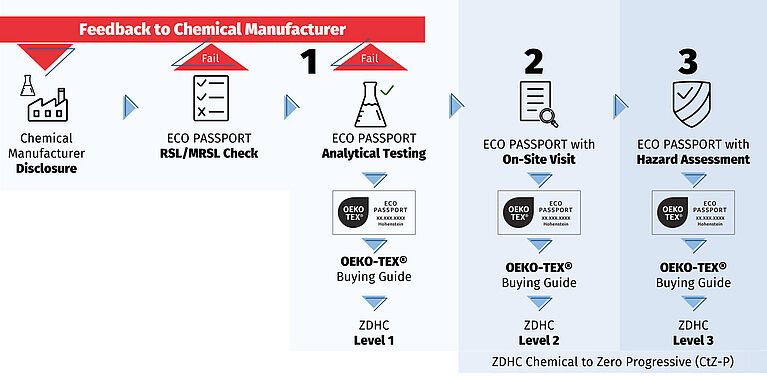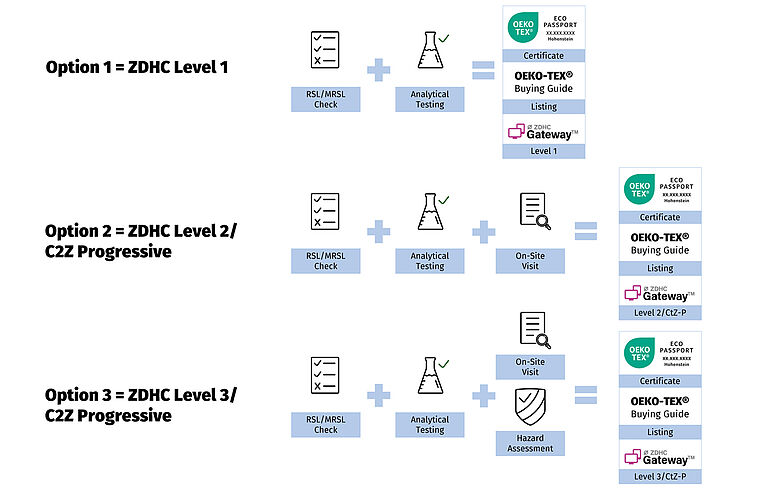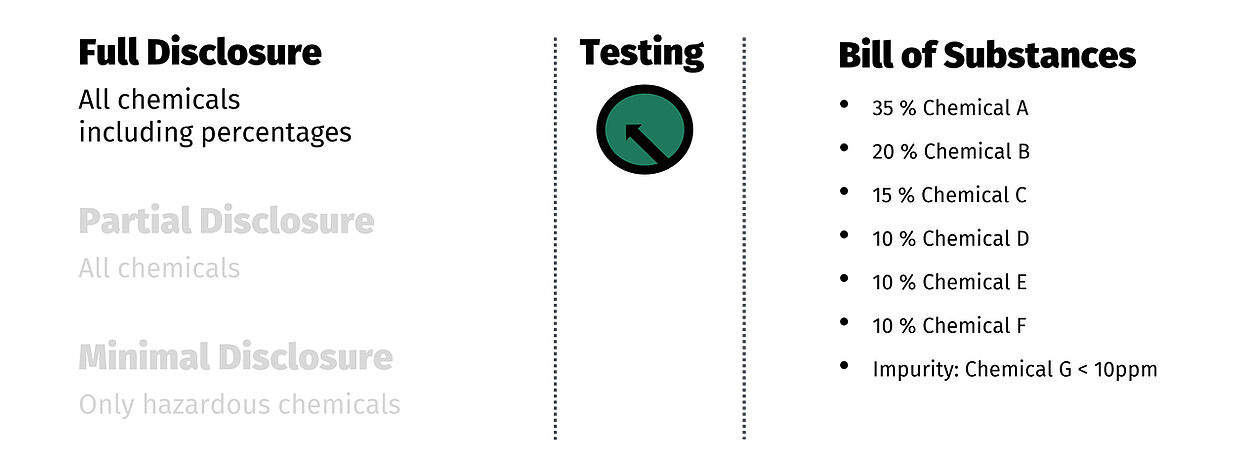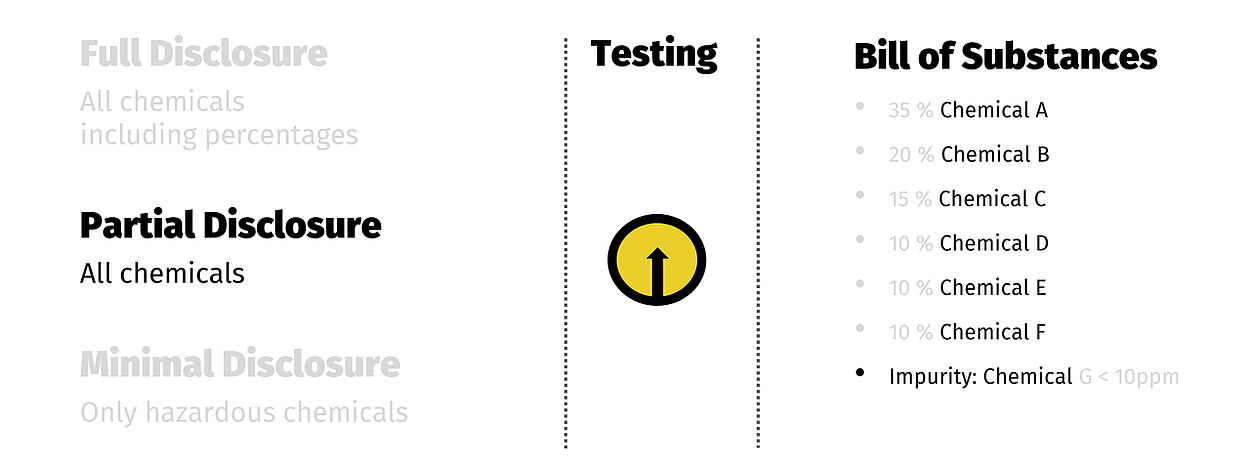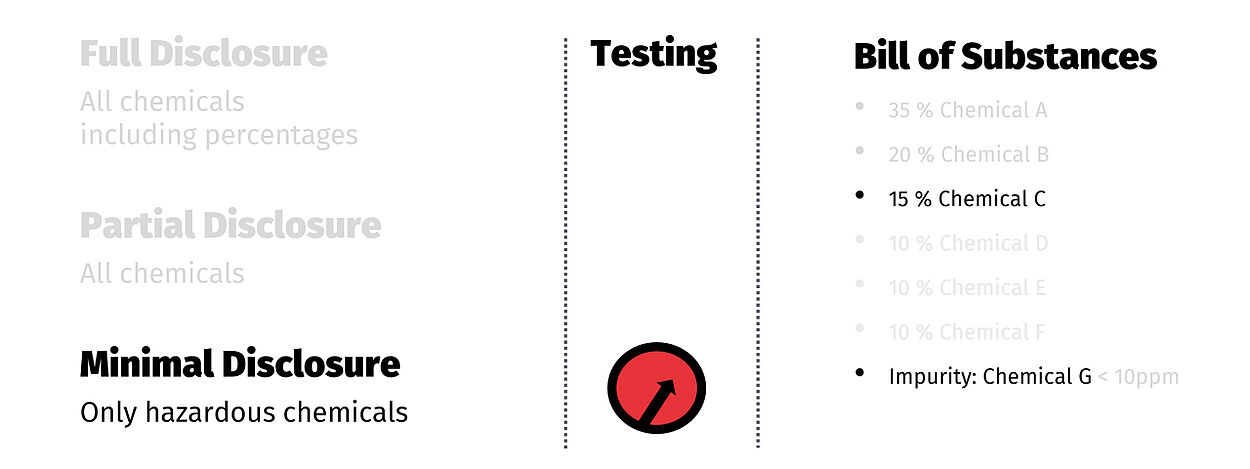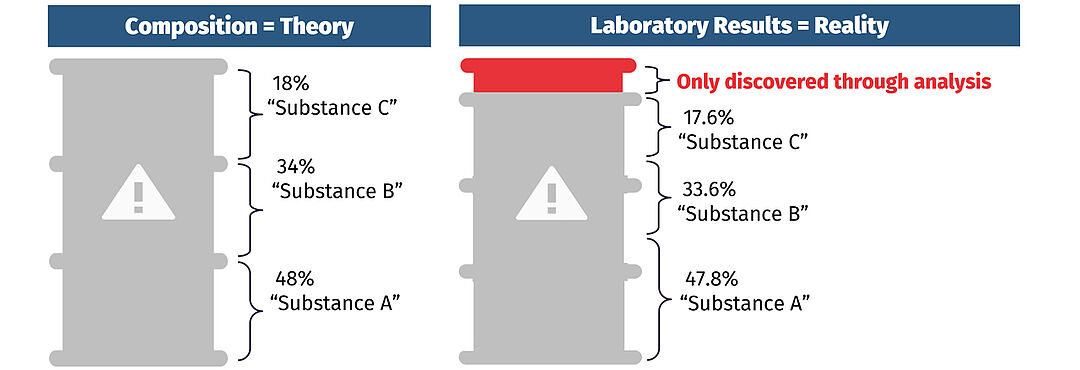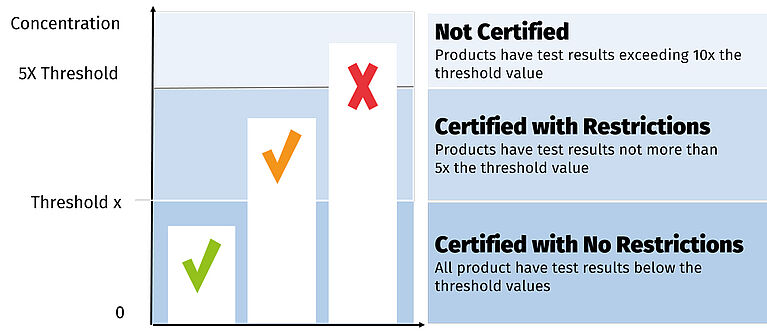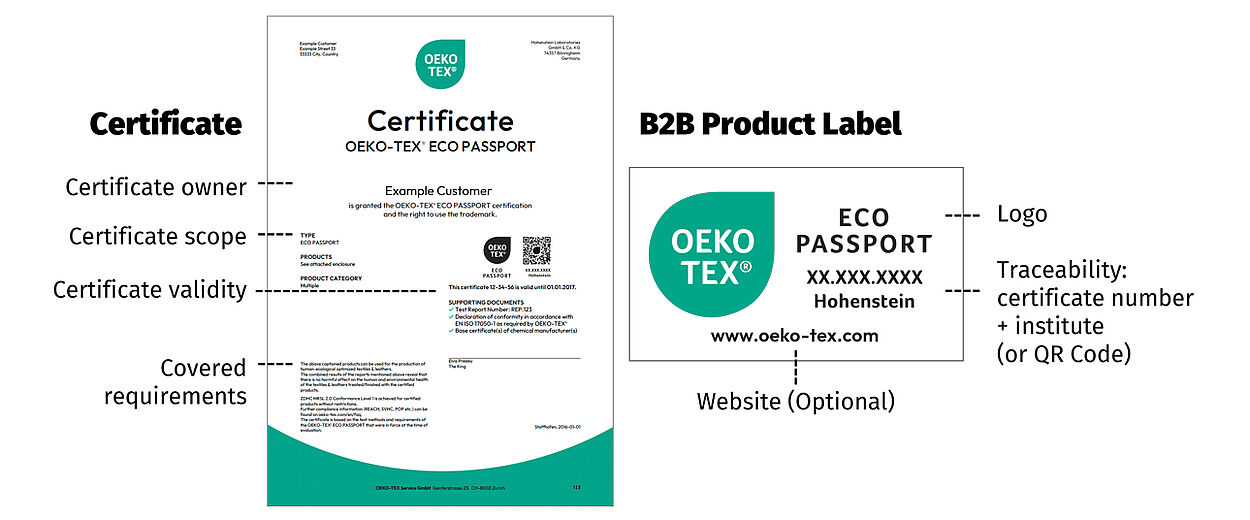What does OEKO-TEX® ECO PASSPORT do?
ECO PASSPORT screens, tests and certifies chemicals before they enter the textile and leather supply chains. It protects workers, the environment and end consumers from harmful substances.
What toxic substances does ECO PASSPORT restrict?
OEKO-TEX® ECO PASSPORT bans or restricts over 1,000 substances that are harmful to human and environmental health. The restricted substance list (RSL/MRSL) is based on scientific data, global regulations and production methods.
Examples include:
- Formaldehyde
Commonly used to enhance fabric durability and wrinkle resistance; Exposure can cause respiratory issues and skin irritation (CDC) - Per- and polyfluoroalkyl substances (PFAS)
Applied for water, grease and dirt repellency; Persistent in the environment and may disrupt endocrine function (EPA) - Phthalates
Often used as plasticizers in synthetic materials; Associated with reproductive and developmental health concerns (NIH) - Azo dyes
Synthetic dyes that can release carcinogenic amines during degradation; Health risks caused by prolonged exposure (NIH) - Flame retardants (e.g., brominated compounds)
Added to reduce flammability; Some are toxic, bioaccumulative and linked to neurobehavioral issues (NIEHS) - Heavy metals (e.g., lead, cadmium, chromium)
Used in dyes and pigments; Exposure can lead to organ damage (ATSDR) - Volatile organic compounds (VOCs) (e.g., benzene, toluene)
Solvents used in textile processing; May cause respiratory and neurological effects (EPA) - Nonylphenol ethoxylates (NPEs)
Used in detergents and surfactants, which degrade into nonylphenol; toxic to aquatic life (EPA) - Organotin compounds
Biocides; Can impair immune and reproductive systems (PubChem) - Aniline
Used to produce dyes; toxic to organs and aquatic life (NIH) - Chlorinated benzenes & toluene
Used to produce dyes and solvents, absorb dyes, degrease raw materials; carcinogenic and reproductive toxicity and risks to aquatic organisms (NIH) - Siloxanes
Used to improve softness, water repellency, durability and appearance, repel oil dirt or grease; risk of bioaccumulation (NIH)
What kinds of chemicals can be certified?
Any chemicals, colorants, auxiliaries and formulations used for the production of textiles and leather can be certified with ECO PASSPORT.
- Auxiliaries
- Fiber, yarn, fabric, foam, rubber production
- Dyeing and printing
- Acids, bases, salts, solvents
- Antifoam/slip, leveling
- Defoamer/stabilizer
- Penetrator
- Rheology modifier
- Water/effluent treatments
- Technical auxiliaries (wetting, anti-foaming, detergents, dispersing, emulsifying, spotting, chelating, stabilizer agents)
- Processing assistants (beamhouse, degreasing, tanning, retanning)
- Colorants
- Dyes (acid, basic, disperse, direct, reactive, azoic, vat, sulfur, solvent, natural, metal)
- Pigments (inorganic, organic, metal, complex)
- Printing pastes, inks (with/without colorants)
- Solvent based finishing
- Finishing assistants/agents
- Coating agents/additives (solvent/aqueous/plastisol based)
- Fatliquors and oils
- Adhesives
- Approved flame retardants and antimicrobials
- Cleaning agents (drycleaning, aqueous, inorganic, degreasing)
- Polymers, masterbatches
- Synthetic resins/pellets
- Commodity chemicals (pH rectifiers, oxidation rectifiers, chelating agents, wastewater and effluent treatment, other)
Restrictions
Explosives, cosmetic, medicinal and microencapsulated chemicals can NOT be certified.
Fragrances to neutralize strong, unpleasant odors in a chemical product, can be certified. But, fragrances to add pleasant smell to can NOT be certified.
Who can apply for an ECO PASSPORT certificate?
- Any manufacturer of textile or leather chemicals can apply for ECO PASSPORT certification. ECO PASSPORT is suitable for all chemical products (chemicals, colorants and auxiliaries) - and their formulations - that are used in the textile, leather, apparel, footwear, home textiles or similar sectors
- Wholesalers and resellers of chemicals can also apply for a certificate in their own name for products already covered by the chemical manufacturer's certificate and no additional changes to the composition have been made
If no manufacturer's certificate is available, it is possible for distributors and retailers to apply for a limited certification. This temporary certification may only be renewed once for a maximum certificate validity of two years total. (Annual certificate renewal for chemical manufacturers is not limited)
How does OEKO-TEX® ECO PASSPORT certify chemicals?
- RSL/MRSL Check
Transparent process to screen for chemicals of concern via cost-effective CAS number comparison - Chemical ingredients are compared with the OEKO-TEX® list of harmful chemicals (~1500 chemicals we are striving to keep out of the supply chain). - Analytical Testing
Analytical verification in our labs to ensure chemicals can be used for the sustainable production of textile or leather products that are safe for human ecology. (Formulations are certified at the minimal level with the option to continue to higher levels) - On-Site Visit (Optional)
Control at chemical supplier facility to check product stewardship system (for ZDHC Level 2/Chemical to Zero Progressive level (CtZ-P))
- plus add optional hazard assessment questions (for ZDHC Level 3/Chemical to Zero Progressive level (CtZ-P))
Which regulations are covered by OEKO-TEX® ECO PASSPORT?
OEKO-TEX® ECO PASSPORT is designed to support global chemical compliance and responsible sourcing. It meets the requirements of key regulations and industry standards, including:
REACH (Regulation (EC) No. 1907/2006)
- Limits and threshold values align with relevant entries in Appendices XVII and XIV
- Substances of very high concern (SVHCs) from the ECHA Candidate List are included if relevant to textiles or leather
- Supports REACH Article 33 by reducing supply chain communication duties
POPs Regulation (EU) 2019/1021
- Complies with restrictions on persistent organic pollutants
ZDHC MRSL Conformance
- Recognized by the ZDHC Foundation
- Supports conformance with the latest ZDHC MRSL, including Levels 1, 2 and 3
AFIRM RSL Alignment
- Regularly monitored against the AFIRM Group Restricted Substances List
- Reviewed against additional legal and stakeholder MRSL/RSL lists
What are the options for ZDHC integration?
All options come with listing in the OEKO-TEX® Buying Guide and use of the OEKO-TEX® ECO PASSPORT product label.
Option 1 allows ZDHC Gateway listing at level 1.
Option 2 adds a product stewardship on-site visit and qualifies for ZDHC Gateway listing at level 2 and the ZDHC Chemical to Zero Progressive level (CtZ-P).
Option 3 adds a chemical hazard assessment questions to the on-site visit and qualifies for ZDHC Gateway listing at level 3 and the ZDHC Chemical to Zero Progressive level (CtZ-P).
How do I get my product listed with ZDHC?
- Contact ZDHC directly and get access to the Chemical Gateway
- Submit the registration for your product
- Provide your OEKO-TEX® ECO PASSPORT certificate and number as proof of compliance with ZDHC standards
- Through an integration with our database, ZDHC will automatically verify the validity and class of the ECO PASSPORT certification
How much disclosure is required?
Protecting confidentiality while reducing fees:
We recognize that chemical formulations and bills of substances (BoS) are highly guarded intellectual property. The information provided is encrypted and stored by the certifying institute and OEKO-TEX®. No recipes are publicly shared anywhere.
- 100% disclosure of your formulation is not mandatory
- The more you can disclose about your formulation, the easier the process of certification
- Greater disclosure reduces your testing costs
- Confidentiality is built into the system, but we are happy to sign an additional non-disclosure agreement (NDA)
- To protect the lab teams during handling, OEKO-TEX® requires the disclosure of all constituent substances and known contaminants/by-products that are regulated by OEKO-TEX® or classified as hazardous by GHS or article 57 of the REACH regulation 1907/2006
Disclosure Level Options - Disclose more, test less:
With higher disclosure levels, testing effort, time and costs for the analytical verification stage are reduced.
Why is analytical verification required?
Disclosed does not always match reality. Testing ensures the certified chemicals do not contain unwanted impurities and side products (incorrect solvents, metals, surfactants, etc.).
Why does OEKO-TEX® test for chemicals for biodegradability?
Some chemicals (e.g. surfactants, softeners and complexing agents) used in textile and leather production end up in wastewater. OEKO-TEX® ECO PASSPORT certification requires that these chemicals are not permanently harming ecosystems.
Biodegradability Requirements:
- Softeners and complexing agents: 90 w-% of the components biodegradable under aerobic conditions or inherently biodegradable and/or eliminable in sewage treatment plants
- Surfactants: Biodegradable under aerobic conditions
- Non-ionic and cationic surfactants: Also biodegradable under anaerobic conditions
These test methods can be conducted by any 3rd-party lab:
- OECD 301 A
- ISO 7827 OECD 301 B
- ISO 9439 OECD 301 C
- OECD 301 D
- OECD 301 E
- OECD 301 F
- ISO 9408 OECD 310
- ISO 14593 ISO 10708
Example Chemical Categories:
- Dispersing agents and protective colloids
- Dyeing wetting agents, deaeration agents
- Emulsifiers
- Wetting agents
- Detergents, dispersing and emulsifying agents
- Spotting agents
- Chelating agents
- Aqueous -Cleaning agents
- Degreasing agents
- Antifoam / slip agents
How are the testing results rated?
Threshold values are published in the ECO PASSPORT standard.
- Substances 'certified without restrictions' fulfill the requirements of downstream certifications, such as STANDARD 100 and LEATHER STANDARD. Only products 'certified with no restrictions' are eligible for listing in the ZDHC Gateway
- Any substances that are 'certified with restrictions' are mentioned on the ECO PASSPORT certificate so that they can be tested again during a downstream certification process
What is ECO PASSPORT product stewardship?
The on-site visit verifies that the manufacturer has systems in place for environmental management, health and safety, quality management and social responsibility. It is currently optional for OEKO-TEX® ECO PASSPORT but required for ZDHC Levels 2 and 3.
Product stewardship checks:
- Certificates for environmental management system
- Documentation on wastewater treatment and waste handling
- Commitments to worker health and safety (training records)
How long is an ECO PASSPORT certificate valid?
An ECO PASSPORT certificate is valid for one year. Certificate owners may apply to renew the certificate up to three months before it expires.
How can the ECO PASSPORT certification and label be used?
An OEKO-TEX® ECO PASSPORT certificate and label are awarded only when all the chemical products meet the test criteria.
The product label can be used for marketing communications specific to the certified chemical.
Since the label is a protected trademark, all companies using the label must comply with the labeling rules. Forgery and misuse of the trademark can be prosecuted under criminal and civil law.
The label and claim are NOT intended for identifying certified ingredients of another product. For example, this type of statement is not allowed: "the chemicals in this [fabric] are ECO PASSPORT certified".
For purchasing, the label is not sufficient proof of successful testing. Buyers should always require the supplier to submit a valid OEKO-TEX® certificate. The details on the ECO PASSPORT label (test number and test institute) must correspond to those on the certificate and the product must be included in the certificate scope.
Please view the labeling guide and contact us with questions.
How much does ECO PASSPORT certification cost?
ECO PASSPORT certification fees are made up of:
- License fee - fixed - annual
- Company audit fee - for levels 2/3 - fixed - 1st year, then every 3 years
- Testing fees - variable - annual
- Fees are based on the testing expenses for the specific chemical product(s) and groupings
- Contact us for a quote based on required testing
How does ECO PASSPORT work within OEKO-TEX®?
ECO PASSPORT is perfectly aligned with the modular OEKO-TEX® System. Chemicals, colorants and auxiliaries that are OEKO-TEX® ECO PASSPORT certified are also recognized by STANDARD 100 and LEATHER STANDARD, for the MADE IN GREEN label and as part of STeP facility certification.
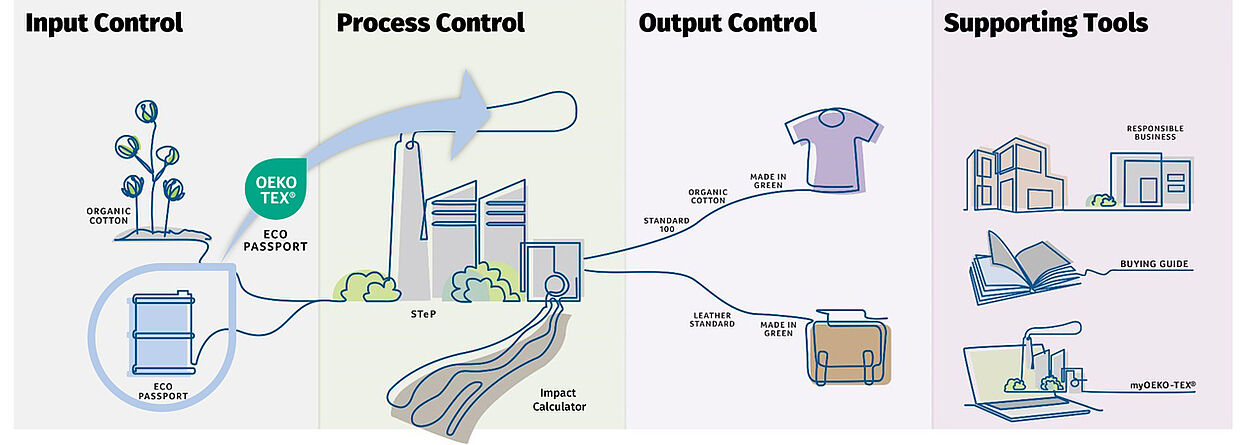
Can biocides or flame retardant ingredients be certified?
Biologically active biocides and flame retardant substances must be approved on the OEKO-TEX® Active Chemical Products list prior to being used in products with any OEKO-TEX® certification.
Contact us to start the approval process.

